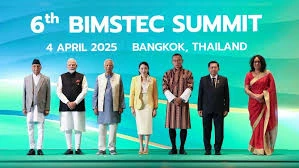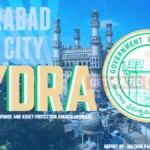Modi at BIMSTEC has reignited the debate over the effectiveness of regional summits. While such gatherings promote diplomacy and cooperation, the lack of tangible outcomes risks turning them into mere photo ops rather than engines of progress.

Being the largest nation in South Asia, New Delhi faces the challenge of spearheading the creation of a revolutionary regional organization.
Formally speaking, Prime Minister Modi’s trip to Thailand last week to attend the 6th BIMSTEC conference seemed to have gone smoothly. He held several significant bilateral meetings with leaders, including Thai Prime Minister Yingluck Shinwatra, Nepal Prime Minister K.P. Sharma Oli, Myanmar Senior General Min Aung Hlaing, and Mohammed Yunus, the Chief Adviser to the government of Bangladesh, in addition to restating India’s eastern region policy. Modi outlined many plans to strengthen ties with member countries and marketed BIMSTEC as a “vital bridge between South and Southeast Asia” in his speech during the meeting.
The issue is that, despite India’s Look East and Act East policies having been in place for more than 30 years, we are still only sketching out ideas and constructing bridges rather than implementing them.
For instance, BIMSTEC has been in one form or another since 1997, and its inaugural summit was held in 2004. But it’s still mostly a talking shop as of right now. This is what SAARC was prior to its demise due to animosity between India and Pakistan. The fact that BIMSTEC has only hosted six summits in the last 27 years is a clear sign of its weakness. Two decades after the BIMSTEC Free Trade Area Framework Agreement (BFTAFA) was signed in 2004, its supporting agreements are still being worked out. Compared to its potential, trade inside the grouping is still restricted.
The 1,300-kilometer India-Myanmar-Thailand Trilateral Highway was started in 2002 and took India about 20 years to finish. However, because of the political climate in Manipur and Myanmar, it has not yet been used to its full potential. Also unfinished is the Kaladan Multi-Modal project, which was started in 2010 and would connect Kolkata and Mizoram via Myanmar. The issue India faces in BIMSTEC is that Myanmar, the nation that holds the key to opening ASEAN’s gates, is embroiled in a protracted civil war that has recently gotten worse.
Before India backed the establishment of BIMSTEC’s permanent secretariat in Dhaka in 2014 and campaigned for the BIMSTEC Charter’s approval in 2022, the organization had actually remained in the background. When relations with Pakistan deteriorated and India abstained from the SAARC summit following the Uri attack by Pakistani proxies in 2016, it made the decision to place more focus on the grouping. All SAARC members are included in the organization, with the exception of Pakistan, Afghanistan, and the Maldives, as well as ASEAN members Myanmar and Thailand.
Regarding SAARC, it was established in 1985 after the then-leader of Bangladesh, Ziaur Rehman, proposed the notion of a South Asian regional organization. However, the organization’s main goal of connecting the nations in the region through trade and connectivity has not been accomplished. Its 2004 decision to establish a free trade area in South Asia by 2014 has not yet materialized. Although intra-regional trade within SAARC has increased from 3% of total trade in the 1990s to 6-7% in recent years, it still falls well short of potential given that ASEAN’s intra-regional trade surpasses 25%.
At least until 2014, SAARC maintained an institutional framework and held yearly meetings with a secretariat in Kathmandu. There is little security coordination and inconsistent physical and digital communication throughout the region.
Pakistan is the main issue. Its backing of proxy forces against India has stalled the majority of projects, whether they are related to connectivity or security. Due to South Asia’s common history, geography, and economic complementarities, SAARC cooperation has not yet been realized.
Geography has given India a good hand in South Asia. All its neighbours border India and none border each other. And all of them combined are smaller than India. India would be the prime beneficiary of a functioning regional organization, but it has not been able to push for the effective functioning of one.
In the context of Modi at BIMSTEC, concerns persist among smaller SAARC nations that their voices—especially on security—may be overshadowed by regional giant India. Ironically, the narrative has often leaned the other way, with India frequently raising alarms about threats from its neighbours and securitising its diplomatic discourse. While such concerns may be valid in the case of Pakistan, known for backing jihadi proxies in Jammu & Kashmir, India has at times overstated issues with countries like Bangladesh, Sri Lanka, and Nepal—causing regional friction and mistrust.
As part of the broader shift highlighted during Modi at BIMSTEC, a positive development has been India’s growing inclination to de-securitise its approach toward neighboring countries. Rather than fixating solely on Chinese influence, India stepped up to support Sri Lanka during its 2022 debt crisis with a generous $4.5 billion assistance package. Beyond that, India has actively engaged in energy and connectivity projects to strengthen Sri Lanka’s infrastructure and has played a pivotal role in its debt restructuring process.
The warm reception Modi received during his official visit to Colombo last week, while returning from the BIMSTEC summit in Thailand, was undoubtedly due to this. Since the election of Anura Dissanayake’s government, the tenor and tone of relations between India and Sri Lanka have shifted. In addition to signing an MOU on defense cooperation, Modi received Sri Lanka’s highest honor.
Modi at BIMSTEC: How India Strengthened Ties with Maldives Despite Political Strains

In line with the evolving diplomatic stance seen during Modi at BIMSTEC, India has demonstrated strategic patience even in challenging political environments—such as with the anti-India government in the Maldives. Rather than reacting defensively to Chinese involvement, New Delhi stepped up with increased support, boosting financial assistance to the island nation by nearly 30% this fiscal year. India also extended emergency aid to help the Maldives avoid a potential debt default, reinforcing its role as a stabilizing partner in the region.
Being the largest nation in South Asia, New Delhi faces the challenge of spearheading the creation of a revolutionary regional organization. India’s shortcomings include significant internal developmental obstacles that limit its capacity to offer its neighbors further economic support. In addition, it must cope with failing nations like Pakistan and Myanmar, where military regimes dominate to the detriment of their own citizens. However, New Delhi must also make better use of the advantages it has been granted and avoid becoming embroiled in unnecessary conflicts, such as the one it had with Nepal in 2015. Although Pakistan is the largest obstacle, ignoring it and forgoing sexual relations is a non-policy that is unlikely to produce any significant outcomes.
Modi at BIMSTEC has once again brought to light the persistent challenges India faces in revitalizing both BIMSTEC and SAARC. These regional groupings hold immense potential—not only to counterbalance China’s growing influence but also as platforms for India to pursue its strategic goals. However, unlocking this potential requires more than diplomacy; it demands sustained momentum, increased funding to secure buy-in from smaller member states, and robust policy planning backed by efficient execution from the Indian government.
Manoj Joshi works at the Observer Research Foundation in New Delhi as a Distinguished Fellow.
















